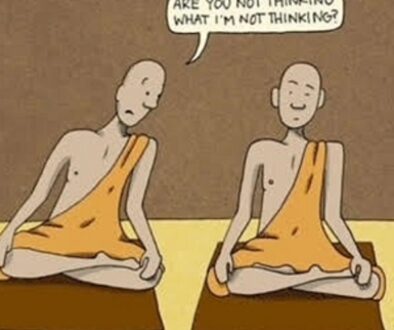GUEST PRIME POST! The Nondual Egg in the Bottle by John Ames

The Nondual Egg in the Bottle
By
John Ames
“I am going to show you how to accomplish a seemingly impossible task using science!”
Oh god! The class sensed education in the air. A light shuffling of feet broke out. When had the word “science” ever been coupled with anything interesting? At age fourteen, we knew that rockets and stuff were somehow related to science, but the word itself had nothing of the cool rumbling or exploding excitement of the things that were supposedly based on it. Still, our teacher, Mr. Gonzalez, had mentioned that his demonstration would involve fire, so there was just the smallest chance that something interesting might happen. We were wary, yes, and prepared for the almost inevitable disappointment, but maybe this time…
From a nook in his desk, Mr. Gonzalez produced four items: a milk bottle, a boiled egg, a box of kitchen matches, and a twist of paper. Without comment, he lined them up on the desk in front of him. Then, with more than usual flair, he asked if anyone in the class could put the egg in the bottle without tearing it apart. No ideas were put forward. He invited two youngsters to come up front and examine his props. The young lady went first and placed the egg tentatively on the mouth of the bottle. It was clearly too big to pass through. The boy took his turn and, disdaining meek experimentation, made as if to smash the egg through, but he was satisfied by the ripple of laughter from the class and replaced the egg undamaged.
“Is there any way this can be done?” Mr. Gonzalez asked.
“I’m not sure,” the girl replied. The boy shrugged his shoulders and assumed the air of a person who might have some ideas but was biding his time.
Mr. Gonzalez sent them back to their seats, then picked up the bottle and turned it every which way. Likewise the egg. Satisfied that everyone understood there was nothing fishy about these commonplace objects, he returned them to the desk. Then with a flourish, he raked a match on his trouser leg, paused as it fired, and then touched it to the twist of paper. When that had burst into flame, he dropped it into the bottle and popped the egg onto the opening. The flame died, smoke issued forth, and for a moment, nothing. Then movement: a slight quivering of the egg, followed by a compression. Inexorably, the egg began to squeeze through the throat of the bottle until, with a thud, it exploded into the space below, intact.
At this point, several hands went up, but Mr. Gonzalez dramatically dismissed the class with no further comment. The magic had been done, and it was only in the next meeting that the subject of excited molecules and atmospheric pressure was broached, things to be vaguely recalled, while the smoky journey of the egg stood out, an indelible memory.
But what has this retelling of an incident from a distant time when milk bottles were commonplace to do with nonduality? No more than any other object really, except perhaps in a metaphorical sense. Anyone who has listened to a spiritual teacher must be familiar with the use of metaphors. Seekers want talk, so teachers oblige. One can only say so many times, “You are God. Now shut up and live with it.” That statement alone seldom suffices. It inevitably leads to questions like, “If that’s so, why don’t I feel like God?” So teachers go on, and out come the metaphors, maybe with a warning about fingers and moons. A similar warning could be issued about eggs in bottles.
I must admit that I can’t get enough of metaphors. Possibly, I’m addicted. A good metaphor is like a drink of water after you’ve suddenly realized you’re thirsty. That drink of water is not by itself going to keep you alive, but it is great in the moment. A famous sage was once asked, “Are you afraid of death?” and he answered, “I’m dead already.” But thousands of people saw him drink water. For me, it’s the same with metaphors. They are a delight in and of themselves and the suspicion that they have anything to do with one’s true nature makes them especially refreshing.
Yes, but can’t they stand in the way? Yeah, just like everything else. I once had an exchange with a pretty well-known teacher, and I was surprised to learn that he thought certain people could channel the dead, which even if true, struck me as an unnecessary complication for both the living and the deceased. I was desperately trying to simplify things and here he was opening a spacious can of worms. He recognized my concern and gave me some of the best spiritual advice I ever got: “John, we should hold these things very lightly.” The same must be said of metaphors.
Since the subject is eggs, I hope it won’t seem too far afield if I recount one of my favorite metaphors involving egg producers. A sage gave each of three monks a chicken with the instruction,”Go somewhere nobody can see you and kill the chicken.” The monks set off. One went into a nearby alley, killed the chicken, and was back in a few minutes. Another went into the countryside, killed the chicken, and was back in an hour. The day passed with no sign of the third monk. As the sun was setting, he appeared carrying a live chicken. “Why didn’t you kill it?” the sage asked. “I couldn’t find anyplace where the chicken couldn’t see me.”
I had a good laugh when it occurred to me that I always had a chicken with me. Something opened up as a result of that metaphor and it was not strictly or even mostly intellectual. Mainly it was understanding, pure and simple. In fact, I understood it before I understood it. That’s what I like about metaphors. They are fascinating, even if I can’t put into words what they mean, but the fact that they are fascinating means that really I do understand. I never have to write an essay explaining what each aspect of the metaphor symbolizes. All I have to do is hold it lightly and let it do its work.
Any spiritual discourse is bound to include metaphors. We tend to appropriate for ourselves the ones that capture something about the inexpressible, even if we’re not sure what. For those of us who are obsessed with awareness, it might be a sun and clouds metaphor. To indicate the indescribable state of conscious awareness, we say it’s sunny. Otherwise, it’s cloudy. If we try to go at it directly, then we use words like “expanded” or “contracted,” but if we look more closely, we see that we are right back into metaphor again, subtler perhaps but metaphor still. What is there to be expanded or contracted? Nothing.
And there’s the trap!
Okay, okay, just hold it lightly. Fuzz up your sharply delineating mind, officer. Take that much-mentioned chill pill. A bit of metaphoric massage might do you good if you don’t use it as an excuse to stiffen up even more. Let’s not mix metaphors and expectation.
Speaking of expectation, if you have read this far, you may be wondering if I am ever going to get back to that egg in the bottle. Let me give you the answer of answers: yes.
When I do an Internet search on “egg in a bottle,” I find a myriad of written directions and videos on how to replicate this ancient memory of mine. Clearly, the demonstration has legs. In an electronic world, kids still marvel at the sight of an egg squeezing into a bottle. Why does it fascinate? I won’t speak for modern youth, but I can observe some things about this process that make it a gripping metaphor for me.
It’s an egg, an immature creature. Even so, it’s too big. How can it be put inside that confining bottle without being irreparably crushed? What needs to be done? Well, it has to be solidified, stripped of its natural protection, and subjected to pressure. That is how the seemingly impossible was accomplished in the past and still is in the present day.
Somehow kids relate to this scenario. I certainly did.
As I left the classroom that day long ago, I found myself feeling for the egg. My last sight of it was in a smoky bottle filled with ash and debris. It was unclean, somehow disrespectful, and one could imagine the violent process by which the egg would be extracted, or worse yet, the unholy mixture of glass and egg if the bottle were broken in the process. We seemed to be facing a precarious dead end. As I walked down the hall, the gray lockers on each side of me seemed to close in even more than usual, and I was relieved to step outside the building.
In class the next day, Mr. Gonzalez once again stood in front of us, and he produced not a bottle with a filthy egg inside, but a nice clean one with the shiny egg clearly visible. This was a gift, but what came next was a greater one. Mr. Gonzalez tipped the bottle upwards, causing the egg to fall into the neck of the bottle. Then he raised it to his lips, blew in a breath of fresh air, and the egg popped out none the worse for wear. During the subsequent lecture, I didn’t take in much of what my teacher said about the universal laws by which these wonders had been performed. It was enough for me to understand that the egg could eventually be free of the bottle.
John Ames is the editor of both this website and Fred’s books.
[From Fred]
I’d never seen this experiment done, so I went to YouTube, and there it was.
Click the link!
The Air in the Bottle (and Out Again!) Experiment




May 9, 2016 @ 11:03 am
Thanks, John. Words, metaphors, pointers are all needed to reach the absolute. The Zen Master Dainin Katigiri wrote a book entitled “You Have to Say Something” partly in response to the prevalent idea that words are all misleading, and only silence can reveal the truth. But…you have to say something!
May 9, 2016 @ 4:00 pm
Great Kathleen. I think this ties in with the last magnolia blossom post I put up today.
May 9, 2016 @ 4:02 pm
Thanks for the comment, Kathleen. Very nice to see that someone else gets a kick out of metaphors. And thanks for mentioning the Zen master’s book. I will look into it. Love, John
May 12, 2016 @ 3:27 pm
Thanks John, this is a new one for me. I too have to Youtube it. And knowing what it meant to you in the end (and now me) … sweet!
Fred once wrote something like every individual is a unique archetype for everyone else. That set off for me helpful recognitions of our diseases being metaphors (i hope that’s the right term/use) for everyone else, not just the carrier. Addiction: the form hides everyone’s addiction to self. Co-dependency: i’ll support you as being your story if you pretend too that my story is what i am. Hypochondria: it’s focusing on a problem that makes it a problem. Schizophrenia: well, who doesn’t have voices in their head! – thank you schizophrenics for showing me outwardly how crazy that is! Multiple Personality Disorder: including the mythical one, the Wizard of Oz – that Isn’t! behind the curtain. And so i’m not just focusing on disease, marriage: all One.
Clear skies everyone, Mike
May 13, 2016 @ 1:53 pm
Thanks, Mike, for your interesting comments. It’s generous of you to share them. Confronting the conditions you mention often tends to provoke a contraction, even marriage sometimes, but using your technique can help change one’s perspective to a desirable thanks-for-the-lesson. I will remember it. Love, John
May 15, 2016 @ 11:32 am
From Oneness it seems everything can be a metaphor. I love them too. Thanks John. That story reminded me of my own science teacher, who could be equally “scrupulous” trying to make us think for ourselves out of the box. Thanks to Mike too. In psychology there is the term collusion concerning relationships. Fun read.
May 16, 2016 @ 9:33 am
Thanks, Robbin. I’d like to hear more about your science teacher. They can have such an impact. My best friend in high school was profoundly influenced by his favorite and still speaks in reverent tones of Mrs. Johns. She is probably the reason he studied zoology in college. He scored a point higher than me on the national English exam, but he chose science. Love, John